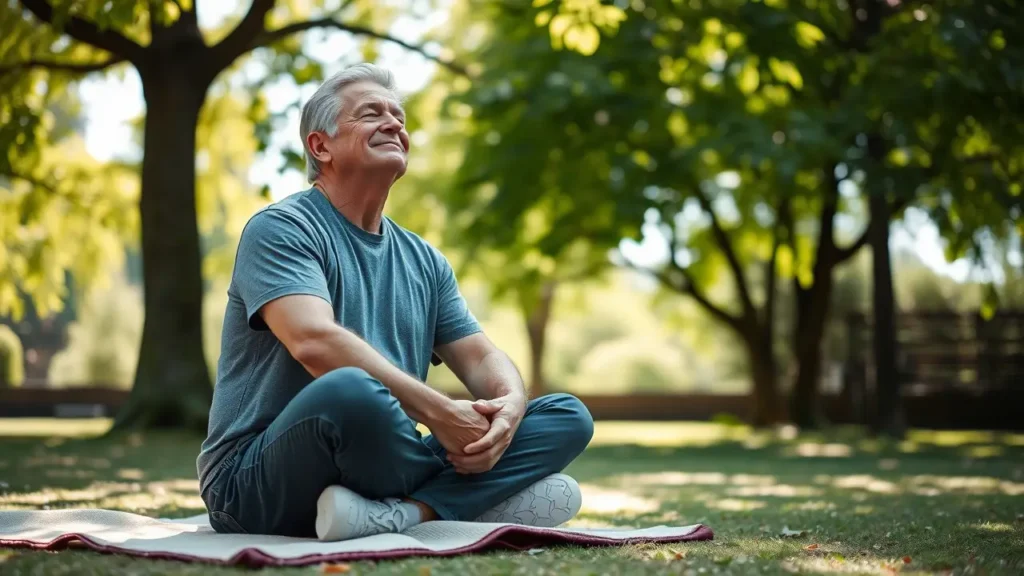Mindfulness has become a buzzword in recent years, but its benefits are far from fleeting. For men in their early 50s and beyond, mindfulness can be a powerful tool to navigate life’s transitions with grace and intention. Whether you’re dealing with career shifts, health concerns, or simply seeking a deeper sense of purpose, practicing mindfulness daily can help you stay grounded, focused, and emotionally balanced. In this article, we’ll explore the best ways to incorporate mindfulness into your everyday routine, offering practical tips, insights, and tools tailored specifically for men over 50.
Understanding Mindfulness: More Than Just a Trend
Before diving into the “how,” it’s important to understand the “why.” Mindfulness is the practice of being fully present in the moment without judgment. It’s about tuning into your thoughts, emotions, and surroundings while cultivating an attitude of acceptance. Research shows that mindfulness can reduce stress, improve focus, and even enhance physical health.
For men in their early 50s, this practice can be particularly beneficial. Life at this stage often involves significant changes—retirement planning, caring for aging parents, or adjusting to an empty nest. These transitions can bring uncertainty and stress, making mindfulness an essential coping mechanism.
“Mindfulness isn’t about escaping reality; it’s about embracing it fully.”
— Jon Kabat-Zinn, Founder of Mindfulness-Based Stress Reduction (MBSR)
Starting Small: Building a Mindful Morning Routine
The best way to integrate mindfulness into your life is to start small. A mindful morning routine can set the tone for the rest of your day. Here are some practical steps to consider:
- Wake Up with Intention : Instead of grabbing your phone first thing, take a few moments to breathe deeply and set an intention for the day. Ask yourself, “What do I want to accomplish today?” or “How can I show up as my best self?”
- Practice Gratitude : Spend a minute reflecting on three things you’re grateful for. This simple act can shift your mindset and create a positive outlook.
- Mindful Movement : Engage in light stretching or yoga. Focus on how your body feels as you move, paying attention to any areas of tension or discomfort.
- Breathing Exercises : Try box breathing—inhale for four counts, hold for four counts, exhale for four counts, and pause for four counts. Repeat this cycle five times to calm your nervous system.
By incorporating these habits into your mornings, you’ll find yourself more centered and prepared to face the challenges ahead.

Mindful Eating: Savoring Every Bite
Mindfulness isn’t limited to meditation; it extends to all aspects of life, including eating. Many men in their 50s struggle with maintaining a healthy diet due to busy schedules or emotional eating patterns. Practicing mindful eating can transform your relationship with food and improve your overall well-being.
Here’s how to eat mindfully:
- Eliminate Distractions : Turn off the TV and put away your phone. Focus solely on your meal.
- Engage Your Senses : Notice the colors, textures, and aromas of your food. Take a moment to appreciate the effort that went into preparing it.
- Chew Slowly : Pay attention to each bite. Chew thoroughly and savor the flavors before swallowing.
- Listen to Your Body : Eat when you’re hungry and stop when you’re full. Avoid using food as a way to cope with stress or boredom.
A study published in the Journal of Obesity found that mindful eating leads to better digestion, reduced overeating, and improved satisfaction after meals. By adopting this approach, you’ll not only nourish your body but also cultivate a deeper connection with your senses.
Incorporating Meditation into Your Day
While mindfulness can be practiced anytime, anywhere, formal meditation remains one of the most effective ways to deepen your practice. Meditation doesn’t have to be complicated or time-consuming. Even ten minutes a day can yield significant results.

Guided vs. Silent Meditation
| Type | Benefits | Best For |
|---|---|---|
| Guided | Provides structure and support | Beginners or those who prefer guidance |
| Silent | Encourages self-reflection and independence | Experienced practitioners |
If you’re new to meditation, try a guided session using apps like Calm or Headspace. These platforms offer meditations tailored to different needs, such as stress relief, sleep improvement, or focus enhancement. For silent meditation, find a quiet space, sit comfortably, and focus on your breath. When your mind wanders (and it will), gently bring your attention back to your breathing.
Tips for Success
- Choose a consistent time and place for meditation to build a habit.
- Start with short sessions and gradually increase the duration.
- Be patient with yourself—it’s normal to feel restless or distracted initially.
“You don’t need to quiet your mind completely to meditate successfully. Simply observe your thoughts without attachment.”
Mindfulness in Motion: Staying Present During Physical Activity
Physical activity is crucial for maintaining health in your 50s, and combining it with mindfulness can amplify its benefits. Activities like walking, swimming, or gardening provide excellent opportunities to practice presence.
When engaging in physical activity, focus on:
- The rhythm of your breath
- The sensation of your muscles working
- The sights and sounds around you
For example, during a walk, notice the texture of the ground beneath your feet, the rustling of leaves, or the warmth of the sun on your skin. This heightened awareness not only enhances the experience but also reduces stress and increases enjoyment.
The Role of Technology in Mindfulness
In today’s digital age, technology can either hinder or enhance mindfulness. While excessive screen time can lead to distraction, there are many tools designed to support your practice. Apps, wearable devices, and online communities can keep you motivated and accountable.
Some popular mindfulness apps include:
- Calm : Offers guided meditations, sleep stories, and breathing exercises.
- Headspace : Focuses on teaching meditation techniques through animated videos.
- Insight Timer : Provides a vast library of free meditations led by experts worldwide.
Additionally, fitness trackers like Fitbit or Apple Watch can remind you to take mindful breaks throughout the day. Use these reminders to pause, breathe, and reconnect with the present moment.
Overcoming Common Challenges
Like any new habit, practicing mindfulness comes with its share of obstacles. Below are some common challenges and strategies to overcome them:
Lack of Time
Many men in their 50s juggle multiple responsibilities, leaving little room for personal practices. To address this:
- Integrate mindfulness into existing routines, such as brushing your teeth or commuting.
- Prioritize short bursts of mindfulness rather than aiming for lengthy sessions.
Restlessness
It’s natural to feel restless during meditation or other mindful activities. Combat this by:
- Starting with movement-based practices like tai chi or yoga.
- Gradually increasing the duration of stillness as you become more comfortable.
Doubting Its Effectiveness
If you’re skeptical about mindfulness, remember that consistency is key. Track your progress by noting changes in mood, energy levels, or relationships. Over time, you’ll likely notice improvements that reinforce your commitment.
Frequently Asked Questions (FAQ)
Q: How long does it take to see results from mindfulness?
A: Results vary depending on individual circumstances, but many people report feeling calmer and more focused within weeks of consistent practice.
Q: Can mindfulness help with chronic pain?
A: Yes, research suggests that mindfulness can reduce the perception of pain and improve quality of life for individuals with chronic conditions.
Q: Is mindfulness compatible with religious beliefs?
A: Absolutely. Mindfulness is a secular practice that complements various spiritual traditions without conflicting with specific doctrines.
Final Thoughts: Embrace the Journey
Practicing mindfulness daily is not about achieving perfection; it’s about embracing imperfection and finding peace in the process. As a man in his early 50s, you have the wisdom and life experience to appreciate the value of presence. By committing to mindfulness, you’ll not only enhance your own well-being but also inspire those around you to live more intentionally.



